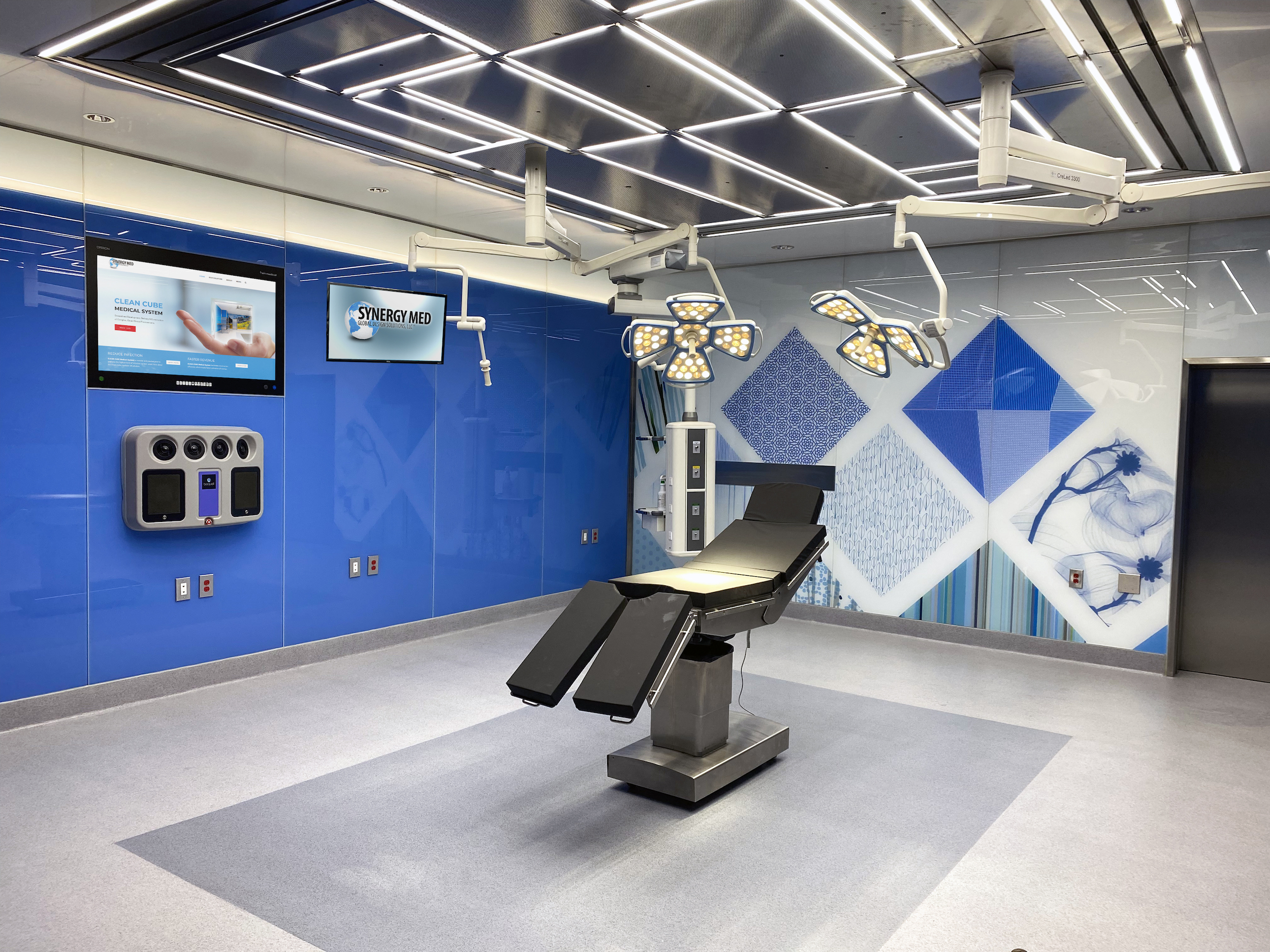The first prefabricated operating room in the world with fully automated disinfection technology opened recently at the University of Rochester Medicine Orthopedics Surgery Center in Henrietta, N.Y. The facility, developed in a former Sears store, features a system designed by Synergy Med, called Clean Cube, that had never been applied to an operating space before.
The components of the Clean Cube operating room were custom premanufactured and then shipped to the site to be assembled. The system was installed in a few weeks. It is composed of modular glass walls that are easier to clean than drywall or stainless steel, and hermetically sealed doors. All mechanical, electrical, and plumbing systems are incorporated into the walls and ceiling. Air handling systems tailored for medical use and automated disinfection systems create a sterile field of air around the patient during surgery.
Development of the Clean Cube system was motivated by a 1 in 25 rate of hospital-acquired infections. The technology is billed as delivering “near-perfect disinfection” to the operating room.
The opening of the Orthopedic Surgery Center completes phase 2 of the 350,000 sf University of Rochester Orthopedic & Physical Performance Center. The delivery of the next phase, a four-story rehab and sports performance center that will include a grand courtyard and sports rehab services, is on track for completion in fall 2023.
“The University of Rochester Medical Center (URMC) will be a defining healthcare project for the country,” says Scott Hansche, principal with SLAM, architect of record for the project. “From a former Sears department store to a world-leading surgery center, we are addressing healthcare equity gaps with quality design and innovation,” Hansche says.
Project team:
Owner and/or developer: Wilmorite
Design architect: Perkins&Will's New York studio
Architect of record: The S/L/A/M Collaborative
Local Associate Architect: Dwyer Architectural
MEP/IT Engineer : ME Engineering
Structural Engineer: Jensen BRV
General contractor/construction manager: Le Chase
Civil Engineer and Landscape Architect: Bergmann Associates
Related Stories
| Nov 26, 2013
Construction costs rise for 22nd straight month in November
Construction costs in North America rose for the 22nd consecutive month in November as labor costs continued to increase, amid growing industry concern over the tight availability of skilled workers.
| Nov 25, 2013
Building Teams need to help owners avoid 'operational stray'
"Operational stray" occurs when a building’s MEP systems don’t work the way they should. Even the most well-designed and constructed building can stray from perfection—and that can cost the owner a ton in unnecessary utility costs. But help is on the way.
| Nov 19, 2013
Pediatric design in an adult hospital setting
Freestanding pediatric facilities have operational and physical characteristics that differ from those of adult facilities.
| Nov 19, 2013
Top 10 green building products for 2014
Assa Abloy's power-over-ethernet access-control locks and Schüco's retrofit façade system are among the products to make BuildingGreen Inc.'s annual Top-10 Green Building Products list.
| Nov 18, 2013
6 checkpoints when designing a pediatric healthcare unit
As more time and money is devoted to neonatal and pediatric research, evidence-based design is playing an increasingly crucial role in the development of healthcare facilities for children. Here are six important factors AEC firms should consider when designing pediatric healthcare facilities.
| Nov 15, 2013
Greenbuild 2013 Report - BD+C Exclusive
The BD+C editorial team brings you this special report on the latest green building trends across nine key market sectors.
| Nov 15, 2013
Pedia-Pod: A state-of-the-art pediatric building module
This demonstration pediatric treatment building module is “kid-friendly,” offering a unique and cheerful environment where a child can feel most comfortable.
| Nov 14, 2013
Behind the build: BD+C's 'Pedia-Pod' modular pediatric patient unit at Greenbuild 2013 [slideshow]
Next week at Greenbuild, BD+C will unveil its demonstration pediatric patient unit, called Pedia-Pod. Here's a behind-the-scenes look at the construction of this unique modular structure.
| Nov 13, 2013
Installed capacity of geothermal heat pumps to grow by 150% by 2020, says study
The worldwide installed capacity of GHP systems will reach 127.4 gigawatts-thermal over the next seven years, growth of nearly 150%, according to a recent report from Navigant Research.
| Nov 8, 2013
Oversized healthcare: How did we get here and how do we right-size?
Healthcare facilities, especially our nation's hospitals, have steadily become larger over the past couple of decades. The growth has occurred despite stabilization, and in some markets, a decline in inpatient utilization.

















